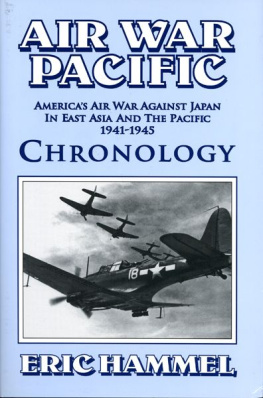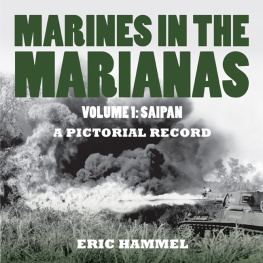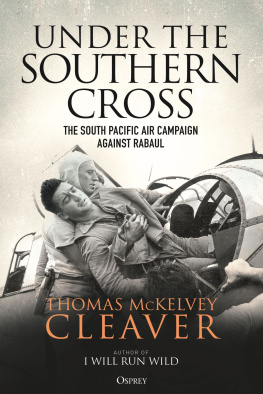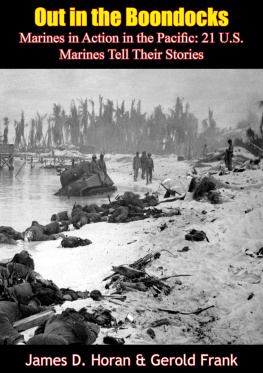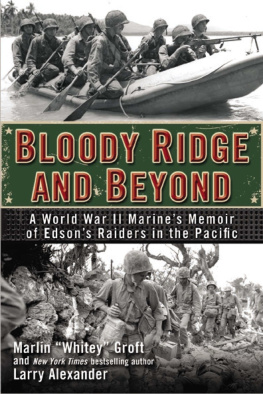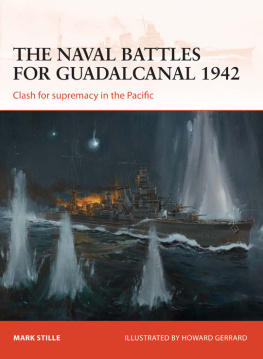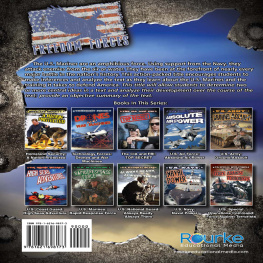
Marines On Guadalcanal
A Pictorial Record
323 Photos
T he six-month Guadalcanal campaign was the longest and most complicated operation U.S. Marines faced in the Pacific War. In July 1942, when it was discovered that the Japanese were building a bomber base on the island, the 1st Marine Division was the only Allied force available to respond to the threat. Although the airfield was seized without a fight after the Marines landed on August 7,1942, a Japanese naval attack the following night drove off the supporting U.S. Navy forces before the transports finished unloading supplies.
Sixteen thousand Marines were on their own, without naval or air support. They had a limited food supply and munitions sufficient for just four days of heavy fighting; the Japanese, however, were able to land fresh troops and supplies from Rabaul, their main regional base, six hundred miles to the northwest. The Marines were repeatedly on the verge of being overrun, and it was not until mid-November that the Americans turned the tide. After being relieved by U.S. Army forces in December, many Marines were too weak to climb the cargo nets to reach the decks of the troop transports that would take them to Australia.
The Guadalcanal campaign began with the weapons and tactics of 1918 combat in France and ended with the tactics that would sweep aside the Japanese defenders of formidable island bases all across the Pacific. Guadalcanal served as a test bed for the leaders, weapons, and techniques that brought the United States to total victory in the Pacific in World War II. This volume of remarkable photographs (many never before published), coupled with Hammels expert analysis, is a tribute to the men who sacrificed so much in winning this vital steppingstone on the path to victory over Japan.
Books by Eric Hammel
76 Hours: The Invasion of Tarawa (with John E. Lane)
Chosin: Heroic Ordeal of the Korean War
The Root: The Marines in Beirut
Ace!: A Marine Night-Fighter Pilot in World War II (with R. Bruce Porter)
Duel for the Golan (with Jerry Asher)
Guadalcanal: Starvation Island
Guadalcanal: The Carrier Battles
Guadalcanal: Decision at Sea
Munda Trail: The New Georgia Campaign
The Jolly Rogers (with Tom Blackburn)
Khe Sanh: Siege in the Clouds
First Across the Rhine (with David E. Pergrin)
Lima-6: A Marine Company Commander in Vietnam (with Richard D. Camp)
Ambush Valley
Fire in the Streets
Aces Against Japan
Aces Against Japan II
Aces Against Germany
Air War Europa: Chronology
Carrier Clash
Aces at War
Air War Pacific: Chronology
Aces in Combat
Bloody Tarawa
Marines at War
Carrier Strike
Pacific Warriors: The U.S. Marines in World War II
Iwo Jima: Portrait of a Battle
Marines in Hue City: Portrait of an Urban Battle
The U.S. Marines in World War II: Guadalcanal
The U.S. Marines in World War II: New Georgia, Bougainville, and Cape Gloucester
The U.S. Marines in World War II: Tarawa and the Marshalls
The Forge
Coral and Blood
The Road to Big Week
Islands of Hell
Always Faithful
The Steel Wedge
Marines On Okinawa
Marines In the Marshalls
Marines On Peleliu

Text Copyright 2012 by Eric Hammel
Book Design and Layout Copyright 2012 by Words To Go, Inc.
All Maps Copyright Meridian Mapping
All rights reserved. No part of this publication may be reproduced or transmitted in any form or by any means, electronic or mechanical, including photocopy, recording, or any information storage and retrieval system, without permission in writing from the publisher.
Requests for permission to make copies of any part of the work should be mailed to: Permissions, Pacifica Military History, 1149 Grand Teton Drive, Pacifica, California 94044.
ISBN-10: 1-890988-59-6
ISBN-13: 978-1-890988-59-3
Book Design and Type by Words To Go, Inc., Pacifica, California
Cover Design by Tom Heffron, Hudson, Wisconsin
Maps by Meridian Mapping, Minneapolis, Minnesota
***
For a complete listing of all the military history books written by Eric Hammel and currently available in print or as ebooks, visit: http://www.EricHammelBooks.com A free sample chapter from each book is available in the sites Free section.
Please also visit http://www.PacificaMilitary.com
This book is respectfully dedicated to the gallant American soldiers, sailors, and Marines who stood their ground and achieved the stunning victory at Guadalcanal.
Glossary and Guide to Abbreviations
A6M Imperial Navy Mitsubishi Zero fighter
Amtrac Amphibian tractor
Avenger U.S. Navy/Marine Grumman TBF carrier torpedo/light bomber
B-17 U.S. Army Air Forces Boeing Flying Fortress four-engine heavy bomber
Betty Imperial Navy Mitsubishi G4M twin-engine land attack bomber
D3A Imperial Navy Aichi Val dive-bomber
Dauntless U.S. Navy/Marine Douglas SBD dive-bomber
F4F U.S. Navy/Marine Grumman Wildcat fighter
Flying Fortress U.S. Army Air Forces Boeing B-17 four-engine heavy bomber
G4M Imperial Navy Mitsubishi Betty twin-engine land attack bomber
LCM Landing Craft, Mechanized
LCVP Landing craft, vehicle, personnel
LVT Landing vehicle, tracked; amphibian tractor; amtrac
M1903 U.S.-built Springfield .30-caliber bolt-action rifle
M3 U.S. light tank
MAG Marine Air Group
P-39 U.S. Army Air Forces Bell Airacobra fighter
P-400 U.S. Army Air Forces Bell Airacobra export variant fighter
PBY U.S. Navy Consolidated Catalina twin-engine patrol bomber
R4D U.S. Navy/Marine Douglas Dakota twin-engine transport
SBD U.S. Navy/Marine Douglas Dauntless dive-bomber
TBF U.S. Navy/Marine Grumman Avenger carrier torpedo/light bomber
Val Imperial Navy Aichi D3A carrier dive-bomber
VF U.S. Navy fighting squadron
VMF U.S. Marine fighting squadron
VMSB U.S. Marine scout-bombing squadron
VS U.S. Navy scouting squadron
Wildcat U.S. Navy/Marine F4F Wildcat fighter
Zero Imperial Navy Mitsubishi A6M fighter




Chapter 1 Before
READY OR NOT
M ajor General Alexander Archer Vandegrift received word on June 26, 1942, that his 1st Marine Division had been selected to invade a Japanese-held island called Tulagi, in the Eastern (or Lower) Solomon Islands. There was no other Allied command to undertake the sudden and urgent mission, and Vandegrifts command was barely up to the task. On the day the news was given, the 1st Marine Division was spread all the way across the breadth of the Pacific, and the Marine Corps felt that it still required a minimum of six months of intense combat training to be considered battle-ready. Nevertheless, Vandegrift was told by his superiors that the Tulagi invasion was of utmost urgency and would take place in little more than four weeks.
Next page


![Hammel - The artists guide to GIMP effects creative techniques for photographers, artists, and designers ; [covers GIMP 2.8]](/uploads/posts/book/138245/thumbs/hammel-the-artist-s-guide-to-gimp-effects.jpg)
